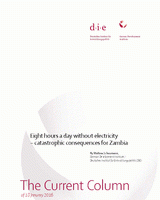Eight hours a day without electricity – catastrophic consequences for Zambia
Scheumann, WaltinaThe Current Column (2016)
Bonn: German Development Institute / Deutsches Institut für Entwicklungspolitik (DIE) (The Current Column of 18 January 2016)
Bonn, 18 January 2016. The energy crisis in Zambia has hit the country hard. The power cuts – from between eight and sixteen hours per day – are down to climate change. There is no doubt about it: Zambia is experiencing a period of drought, along with other sub-Saharan countries. However, Zambia has the potential to secure power supplies and take precautionary measures. Political action is required here.
Zambia's state-run electricity company ZESCO has been incapable of supplying companies and urban consumers since the summer of 2015. These are left without electricity for eight to sixteen hours per day, with water supplies frequently also down, as the pumps cannot work without power. Those who can, turn to diesel generators. In particular, the effects on copper mines are making the headlines: as a result of the outages the Mulyashi Open Pit Mine and Baluba Underground Mine were forced to lay off 1,640 workers in September 2015, as supplies to the private Copperbelt Energy Corporation (CEC) were cut. Since September 2015 CEC has seen its electricity volumes cut firstly by 30 %, later by 16 %. Similarly affected are schools, hospitals, urban households, small companies and agricultural operations of all sizes. One such operation is Zambia Sugar, a large agricultural company that cultivates sugar cane on 16,000 hectares of land. The company's pumps are only able to extract a limited amount of water from the River Kafue; and this has knock-on effects on water supplies to the associated contracted farmers, who grow sugar cane on 4,000 hectares of land. In conjunction with the low copper prices, which have fallen by 18 % since January 2015, Zambia's economy is currently only growing at 3.4 %, in contrast to the previous rate of 7 %.
The official explanation for this catastrophic situation is climate change: the low rainfall and high temperatures (evaporation) have resulted in historically low water levels in the reservoirs. However, as plausible as this may sound, it is only true to a certain degree. The Kariba dam on the Zambezi, which supplies Zambia and Zimbabwe with electricity, is designed in such a way that it cannot only compensate for seasonal fluctuations in rainfall, but also fluctuations across the course of several years. In March 2015 the Zambezi River Authority (ZRA) reduced the allocation of water to Zambia's ZESCO and the Zimbabwean ZPC by 12 %. However, both are exceeding their quota for water – ZESCO by 39 %, ZPC by 16 % –, with the consequence that in November 2015 Zambia and Zimbabwe were only three metres from disaster. At that time the water level at the Kariba dam stood at just 478.51 metres – and electricity can only be generated up to 475.5 metres. ZESCO also needs to ask itself why it has the power station, with 360 megawatts of expanded capacity, generating electricity around the clock and not 3.5 hours a day for peak demand as foreseen. Water passes through the dam around the clock, as noted by Guy Scott, Zambian president from October 2014 to January 2015.
The problem for the country is that it is dependent on too few hydroelectric plants (Kariba and Kafue Gorge supply around 90 % of electricity consumption). Zambia could utilise far more hydroelectric power: It receives the highest rainfall in southern Africa and has 40 % of the region's water resources. Further power plants have long been planned, but have been unable to attract the necessary financing, as the electricity price is not cost-oriented and therefore unattractive for private investors. These subsides are enjoyed by all; not just the poorer households, but also the wealthy mining operations. The Zambian government has also accepted the extensive dependence on hydroelectric energy for too long and been insufficiently active in promoting the development of other sources of energy, in particular renewables. The potential offered by solar energy (six to eight hours of sunshine per day), especially photovoltaic, has so far gone untapped. Although fixed feed-in rates for solar projects are under development, these have yet to enter into effect.
Kofi Annan, who supports the New Deal on Energy for Africa, rightly states: “Africa’s leaders must act with urgency to put in place the policies needed (…) to build climate-resilient societies.” It would be a great achievement if the current energy crisis were to result in a change of course in Zambia.

